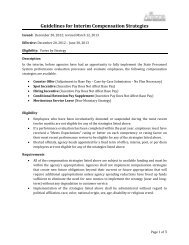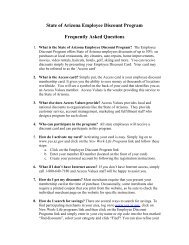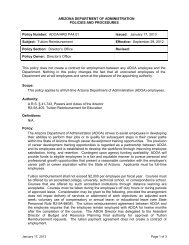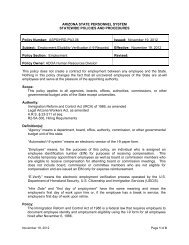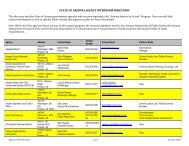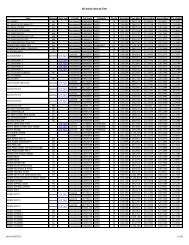arizona department of administration - Arizona Human Resources
arizona department of administration - Arizona Human Resources
arizona department of administration - Arizona Human Resources
Create successful ePaper yourself
Turn your PDF publications into a flip-book with our unique Google optimized e-Paper software.
ARIZONA DEPARTMENT OF ADMINISTRATIONPOLICIES AND PROCEDURESPolicy Number: ADOA/HRD PA6.03 Issued: January 17, 2013Subject: Leave – Family and Medical Leave Act (FMLA) Effective: September 29, 2012Policy Section: <strong>Human</strong> <strong>Resources</strong>Revised:Policy Owner: HRD – Shared Services OfficeThis policy does not create a contract for employment between any ADOA employee and theDepartment. Nothing in this policy changes the fact that all uncovered employees <strong>of</strong> theDepartment are at will employees and serve at the pleasure <strong>of</strong> the appointing authority.Scope:This policy applies to all <strong>Arizona</strong> Department <strong>of</strong> Administration (ADOA) employees.Authority:• Family and Medical Leave Act (FMLA) <strong>of</strong> 1993, as amended• 29 CFR Part 825• National Defense Authorization Act for Fiscal Year 2010 (2010 NDAA)• R2-5A-D601, Family and Medical Leave Act (FMLA) LeaveDefinitions:“12-Month Period” means a rolling 12-month period measured backward from the date leaveis taken and continuous with each additional leave day taken."Armed Forces" includes the following military service branches: Army, Army Reserve,Army National Guard, Marine Corps, Marine Corps Reserves, Navy, Navy Reserves, AirForce, Air Force Reserve, Air Guard, Coast Guard, and Coast Guard Reserves.“Contingency Operation” means a military operation that is designated by the Secretary <strong>of</strong>Defense as an operation in which members <strong>of</strong> the armed forces are or may becomeinvolved in military actions, operations, or hostilities against an enemy <strong>of</strong> the United Statesor against an opposing military force or results in the call or order to, or retention on, activeduty <strong>of</strong> members <strong>of</strong> the uniformed services during a war or during a national emergencydeclared by the President or Congress.“Continuing Treatment” includes any one or more <strong>of</strong> the following:1. A period <strong>of</strong> incapacity <strong>of</strong> more than three consecutive full calendar days combinedwith medical treatment, and any subsequent treatment or period <strong>of</strong> incapacityrelating to the same condition, that also involves:a. Treatment two or more times within 30 days <strong>of</strong> the first day <strong>of</strong> incapacity, unlessextenuating circumstances exist, by a health care provider, by a nurse orphysician’s assistant under direct supervision <strong>of</strong> a health care provider, or by aprovider <strong>of</strong> health care services (e.g., physical therapist) under orders <strong>of</strong>, or onreferral by, a health care provider; orb. Treatment by a health care provider on at least one occasion which results in aregimen <strong>of</strong> continuing treatment under the supervision <strong>of</strong> the health careprovider;January 17, 2013 Page 1 <strong>of</strong> 10
<strong>Arizona</strong> Department <strong>of</strong> Administration (ADOA) Policies and ProceduresSubject: Leave - Family and Medical Leave Act (FMLA)c. The requirement in (a) and (b) for treatment by a health care provider means anin-person visit to a health care provider. The first (or only) in-person treatmentvisit must take place within seven days <strong>of</strong> the first day <strong>of</strong> incapacity.2. Any period <strong>of</strong> incapacity due to pregnancy or for prenatal care;3. Any period <strong>of</strong> incapacity or treatment for such incapacity due to a chronic serioushealth condition. A chronic serious health condition is one which:a. Requires periodic visits (at least twice a year) for treatment by a health careprovider, or by a nurse or physician’s assistant under direct supervision <strong>of</strong> ahealth care provider;b. Continues over an extended period <strong>of</strong> time (including recurring episodes <strong>of</strong> asingle underlying condition); andc. May cause episodic rather than a continuing period <strong>of</strong> incapacity (e.g., asthma,diabetes, epilepsy, etc.)4. A period <strong>of</strong> incapacity which is permanent or long-term due to a condition for whichtreatment may not be effective (e.g., Alzheimer’s, a severe stroke, or the terminalstages <strong>of</strong> a disease). The employee or family member must be under the continuingsupervision <strong>of</strong>, but need not be receiving active treatment by a health care provider;or5. Any period <strong>of</strong> absence to receive multiple treatments (including any period <strong>of</strong>recovery) by a health care provider or by a provider <strong>of</strong> health care services underorders <strong>of</strong>, or on referral by, a health care provider, either for restorative surgery afteran accident or other injury, or for a condition that would likely result in a period <strong>of</strong>incapacity <strong>of</strong> more than three consecutive calendar days in the absence <strong>of</strong> medicalintervention or treatment, such as cancer (chemotherapy, radiation, etc.), severearthritis (physical therapy), kidney disease (dialysis)."Covered Active Duty" means:• For members <strong>of</strong> a regular component <strong>of</strong> the Armed Forces, duty during deployment<strong>of</strong> the member with the Armed Forces to a foreign country.• For members <strong>of</strong> the reserve components <strong>of</strong> the Armed Forces (members <strong>of</strong> the U.S.National Guard and Reserves), duty during deployment <strong>of</strong> the member with theArmed Forces to a foreign country under a call or order to active duty in acontingency operation as defined in section 101(a) (13) (B) <strong>of</strong> title 10, United StatesCode."Covered Service Member for Exigency Leave" means an employee’s spouse, son,daughter, or parent on active duty or call to active duty status in support <strong>of</strong> a contingencyoperation."Covered Servicemember for Servicemember Caregiver Leave" means:• An employee’s spouse, son, daughter, parent, or next <strong>of</strong> kin who is a currentmember <strong>of</strong> the Armed Forces including a member <strong>of</strong> the National Guard or Reserveswho is undergoing medical treatment, recuperation, or therapy, is otherwise inoutpatient status, or is otherwise on the temporary disability retired list, for a seriousinjury or illness incurred in the line <strong>of</strong> active duty.• An employee’s spouse, son, daughter, parent, or next <strong>of</strong> kin who is a veteran who isundergoing medical treatment, recuperation, or therapy for a serious injury <strong>of</strong> illnessJanuary 17, 2013 Page 2 <strong>of</strong> 10
<strong>Arizona</strong> Department <strong>of</strong> Administration (ADOA) Policies and ProceduresSubject: Leave - Family and Medical Leave Act (FMLA)if the veteran was a member <strong>of</strong> the Armed Forces at any time during the period <strong>of</strong>five years preceding the date on which the veteran undergoes that medicaltreatment, recuperation, or therapy.“Hours <strong>of</strong> Service” means the number <strong>of</strong> hours actually worked; does not include any type <strong>of</strong>paid or unpaid leave with the exception <strong>of</strong> military leave.“Intermittent Leave” means leave taken in separate blocks or periods <strong>of</strong> time, due to asingle qualifying reason, usually to accommodate some form <strong>of</strong> regularly scheduled medicaltreatment, or leave taken on an occasional basis for medical appointments or flare upscaused by an FMLA qualifying medical condition.“Key Employee” means a salaried FMLA-eligible employee who is among the highest paid10 percent <strong>of</strong> all the employees employed by the State <strong>of</strong> <strong>Arizona</strong>.“Medically Necessary” is a medical need for the leave, as distinguished from voluntarytreatments and procedures."Next-<strong>of</strong>-Kin" means the nearest blood relative <strong>of</strong> the servicemember, other than thespouse, son, daughter or parent, in the following order <strong>of</strong> priority: blood relatives who havebeen granted legal custody <strong>of</strong> the servicemember by court decree or statutory provisions,brothers and sisters, grandparents, aunts and uncles, and first cousins, unless the coveredservice member has specifically designated in writing another blood relative as his or hernearest blood relative for purposes <strong>of</strong> servicemember caregiver leave, in which case thedesignated individual shall be deemed to be the next <strong>of</strong> kin."Parent" means the biological, adoptive, step or foster father or mother <strong>of</strong> an employee oran individual who stands or stood in loco parentis to an employee when the employee was ason or daughter. Does not include parents-in-law."Reduced Leave/Work Schedule" means a work schedule that reduces an employee’s usualnumber <strong>of</strong> hours per workweek, or hours per workday. A reduced leave/work schedule is achange in the employee’s schedule for a period <strong>of</strong> time, normally from full-time to part-time."Salaried" means paid on a salary basis, as defined in 29 Code <strong>of</strong> Federal Regulations541.118.“Serious Health Condition” means an illness, injury, impairment, or a physical or mentalcondition that involves:• Inpatient care (i.e., an overnight stay) in a hospital, hospice, or residential medicalcare facility, including any period <strong>of</strong> incapacity, or any subsequent treatment inconnection with such inpatient care; or• Continuing treatment by a health care provider.“Serious Injury or Illness” means an injury or illness incurred by a covered servicemember inthe line <strong>of</strong> active duty on active duty that may render the servicemember medically unfit toperform the duties <strong>of</strong> the member’s <strong>of</strong>fice, grade, rank, or rating."Son or Daughter" means a biological, adopted, or foster child, a stepchild, a legal ward, ora child <strong>of</strong> a person standing in loco parentis, who is under 18 years <strong>of</strong> age or 18 years <strong>of</strong>age or older and incapable <strong>of</strong> self-care because <strong>of</strong> a mental or physical disability. For theJanuary 17, 2013 Page 3 <strong>of</strong> 10
<strong>Arizona</strong> Department <strong>of</strong> Administration (ADOA) Policies and ProceduresSubject: Leave - Family and Medical Leave Act (FMLA)purpose <strong>of</strong> Servicemember leave, a son or daughter on “active duty or call to active dutystatus” can be older than 18 years <strong>of</strong> age.“Spouse” means a husband or wife as defined or recognized under <strong>Arizona</strong> state law. Itdoes not include unmarried domestic partners.Policy:A. In accordance with the Family and Medical Leave Act (FMLA) <strong>of</strong> 1993 as amended, jobprotected unpaid family and medical leave will be granted to eligible employees for upto 12 weeks per 12-month period for any one or more <strong>of</strong> these reasons:1. The birth <strong>of</strong> a son or daughter and in order to care for such son or daughter or theplacement <strong>of</strong> a son or daughter with the employee for adoption or foster care (leavefor this reason must be taken in the 12-month period following the son or daughter’sbirth or placement with employee);2. In order to care for the spouse, son, daughter, or parent <strong>of</strong> the employee, if suchspouse, son, daughter, or parent has a serious health condition.3. The employee’s own serious health condition that makes the employee unable toperform the functions <strong>of</strong> his/her position; or4. A qualifying exigency arising out <strong>of</strong> the fact that the employee’s spouse, son,daughter, or parent is a covered servicemember on active duty (or has been notified<strong>of</strong> an impending call or order to active duty) in support <strong>of</strong> a contingency operation.a. A call to duty for purposes <strong>of</strong> leave taken due to a qualifying exigency refers onlyto Federal call to active duty. State calls to duty are not covered unless underthe order <strong>of</strong> the President <strong>of</strong> the United States.b. Qualifying exigencies include:• Issues arising from a covered servicemember’s short notice deployment (i.e.,deployment on seven or less days <strong>of</strong> notice) for a period <strong>of</strong> seven days fromthe date <strong>of</strong> notification;• Military events and related activities, such as <strong>of</strong>ficial ceremonies, programs,or events sponsored by the military or family support or assistance programsand informational briefings sponsored or promoted by the military, militaryservice organizations, or the American Red Cross that are related to theactive duty or call to active duty status <strong>of</strong> a covered servicemember;• Certain childcare and related activities arising from the active duty or call toactive duty status <strong>of</strong> a covered servicemember, such as arranging foralternative childcare, providing childcare on a non-routine, urgent, immediateneed basis, enrolling or transferring a child in a new school or day carefacility, and attending certain meetings at a school or a day care facility if theyare necessary due to circumstances arising from the active duty or call toactive duty <strong>of</strong> the covered servicemember;• Making or updating financial and legal arrangements to address a coveredservicemember’s absence;• Attending counseling provided by someone other than a health care providerfor oneself, the covered servicemember, or the child <strong>of</strong> the coveredJanuary 17, 2013 Page 4 <strong>of</strong> 10
<strong>Arizona</strong> Department <strong>of</strong> Administration (ADOA) Policies and ProceduresSubject: Leave - Family and Medical Leave Act (FMLA)servicemember, the need for which arises from the active duty or call toactive duty status <strong>of</strong> the covered servicemember;• Taking up to five days <strong>of</strong> leave to spend time with a covered servicememberwho is on short-term temporary, rest and recuperation leave duringdeployment;• Attending to certain post-deployment activities, including attending arrivalceremonies, reintegration briefings and events, and other <strong>of</strong>ficial ceremoniesor programs sponsored by the military for a period <strong>of</strong> 90 days following thetermination <strong>of</strong> the covered servicemember’s active duty status, andaddressing issues arising from the death <strong>of</strong> a covered servicemember;• Any other event that the employee and employer agree is a qualifyingexigency.If a husband and wife, both <strong>of</strong> whom are employed by the State <strong>of</strong> <strong>Arizona</strong>, and eachwishes to take leave for the birth <strong>of</strong> a son or daughter, adoption or placement <strong>of</strong> a son ordaughter in foster care, to care for a parent (but not a parent-in-law) with a serioushealth condition, or for a qualifying military exigency, the husband and wife are onlyentitled to take a combined total <strong>of</strong> 12 weeks <strong>of</strong> FMLA leave.B. In accordance with the FMLA <strong>of</strong> 1993 as amended, an eligible employee who is thespouse, son, daughter, parent, or next <strong>of</strong> kin <strong>of</strong> a covered servicemember shall beentitled to a total <strong>of</strong> 26 workweeks <strong>of</strong> leave during a 12-month period to care for theservicemember who is undergoing medical treatment, recuperation or therapy or is inoutpatient status or on the temporary disability retired list for a serious injury or illnessincurred in the line <strong>of</strong> duty while on active duty.If a husband and wife are both employed by the State <strong>of</strong> <strong>Arizona</strong> and each wish to takeleave for the care <strong>of</strong> a qualified service member, the husband and wife shall be entitledto a combined total <strong>of</strong> 26 workweeks <strong>of</strong> FMLA leave.C. In accordance with the FMLA <strong>of</strong> 1993 as amended, an eligible employee shall beentitled to no more than 12 workweeks <strong>of</strong> leave for the reasons under paragraph (A),and a combined total <strong>of</strong> 26 workweeks <strong>of</strong> leave under paragraph (A) and (B) during a12-month period.D. For part-time employees and those who work variable hours, the FMLA entitlement iscalculated on a pro-rata basis. A weekly average <strong>of</strong> the hours worked over the 12weeks prior to the beginning <strong>of</strong> the leave will be used for calculating the employee'snormal workweek, but shall not exceed 40 hours per week.Coverage and EligibilityA. An eligible employee for the purposes <strong>of</strong> the FMLA is an employee who:1. Is an employee <strong>of</strong> the State <strong>of</strong> <strong>Arizona</strong>;2. Has been employed by the State <strong>of</strong> <strong>Arizona</strong> for at least 12 months (need not becontinuous; however, employment prior to a break in service <strong>of</strong> 7 years or moreneed not be counted); and3. Worked for at least 1,250 hours <strong>of</strong> service during the 12-months immediatelypreceding commencement <strong>of</strong> the leave.January 17, 2013 Page 5 <strong>of</strong> 10
<strong>Arizona</strong> Department <strong>of</strong> Administration (ADOA) Policies and ProceduresSubject: Leave - Family and Medical Leave Act (FMLA)B. If at any time during the approved FMLA leave the employee notifies the employer thatthe employee will not be returning to work, FMLA leave entitlement shall cease.Paid LeaveA. An employee on FMLA leave will be required to use appropriate accrued leave. Certainexceptions to an employee having to use accrued leave for unpaid FMLA leave exist,i.e., Industrial Leave.B. When an employee has used all appropriate paid leave time for a portion <strong>of</strong> FMLA leaveand additional time <strong>of</strong>f is needed, the employee may request unpaid leave to be grantedso that the total period <strong>of</strong> leave (paid and unpaid) equals 12 workweeks or 26workweeks dependent on the reason for the leave.C. All paid and unpaid leave taken for an FMLA qualifying event will be applied towards theemployee’s FMLA leave entitlement. For example, an employee using 10 weeks <strong>of</strong>industrial leave would simultaneously exhaust 10 weeks <strong>of</strong> his/her FMLA leaveentitlement.Intermittent Leave or Reduced Schedule LeaveA. An employee may take leave intermittently (a few days or a few hours at a time) or on areduced leave schedule for birth or placement for adoption or foster care <strong>of</strong> a son ordaughter.B. An employee may take leave intermittently or on a reduced leave schedule to care foran immediate family member with a serious health condition or because <strong>of</strong> a serioushealth condition <strong>of</strong> the employee when “medically necessary.”C. An employee who needs intermittent or reduced schedule leave for foreseeable medicaltreatment must work with his/her supervisor to schedule the leave so as not to undulydisrupt the Department’s operations.D. The employee may be required to transfer temporarily to a position with equivalent payand benefits that better accommodates recurring periods <strong>of</strong> leave when the leave isplanned based on scheduled medical treatment.E. While on intermittent FMLA leave, an employee may be required to call in to his/herimmediate supervisor to provide notification that a current absence is for an FMLAqualifying reason. Failure to follow call-in procedures may result in disciplinary action ordismissal from employment.F. While on reduced schedule leave, the Department will not reduce the employee’s FTE.An employee on reduced schedule leave is required to use their paid leave balances forthe periods <strong>of</strong> reduced schedule FMLA leave.G. For uncovered and covered employees who are exempt from earning overtime, straighttime or compensatory leave under the Fair Labor Standards Act (FLSA) for working inexcess <strong>of</strong> 40 hours in a workweek and have been determined by the State to be FLSAexempt, (i.e., are not charged leave for absences <strong>of</strong> less than eight hours in one workday), if FMLA is taken:January 17, 2013 Page 6 <strong>of</strong> 10
<strong>Arizona</strong> Department <strong>of</strong> Administration (ADOA) Policies and ProceduresSubject: Leave - Family and Medical Leave Act (FMLA)1. On an intermittent leave basis (i.e., the employee is absent from work on anoccasional basis): If the employee’s absence is one or more full work day(s), theemployee must use their paid leave for each full day <strong>of</strong> FMLA absence. If theemployee’s absence is less than one work day, the employee does not use theirpaid leave balances (i.e., sick and annual leave) for the time they are absent fromwork. A supervisor may request an employee who is using intermittent leave forscheduled medical treatments to schedule the appointments at times that cause theleast disruption to the work unit, such as early morning or late afternoonappointments.Example: An exempt employee’s regular work schedule is Monday throughFriday from 8:00 a.m. through 5:00 p.m. The employee’s health care providerindicates they need to schedule four follow-up appointments for an FMLA-relatedreason over the next eight weeks. The employee schedules the appointmentsfor when the health care provider’s <strong>of</strong>fice opens, allowing the employee to arriveto work by 9:00 a.m. In this example, deductions are not made to either theemployee’s paid leave balances or the employee’s available FMLA leave.2. On a reduced schedule basis (i.e., the number <strong>of</strong> hours the employee may work perworkweek or per workday is reduced as required through certification from theirhealth care provider). On a reduced schedule FMLA, the employee retains their FTEstatus and must use their paid leave balances (i.e., sick and annual leave) for thetime they are absent from work each day, even partial days.Example 1 (reduced schedule, reduced hours per workweek): An employee’sregular schedule is Monday through Friday from 8:00 a.m. through 5:00 p.m. andtheir healthcare provider indicates they can only work 30 hours per week for thenext eight weeks. The employee works with his/her supervisor to discuss theavailable options to meet the medical certification in a way that would be theleast disruptive to the work unit. Unless the medical provider has also limited thenumber <strong>of</strong> hours the employee can work each day, possible schedules include,but are not limited to the following: three 10-hour days, such as Monday,Tuesday, Wednesday or Monday, Wednesday and Friday; five 6-hour days; or,three 8-hour days and one 6-hour day. In this example, the employee wouldcode the time they are absent from work (the balance <strong>of</strong> the 40 hours, includingpartial days), as either FMLA sick leave (310F), FMLA annual leave (300F),FMLA LWOP (640F), or other FMLA pay codes as applicable.Example 2 (reduced schedule, reduced hours per workday): An employee’sregular schedule is Monday through Friday from 8:00 a.m. through 5:00 p.m. andtheir healthcare provider indicates they can only work four hours per day for aperiod <strong>of</strong> two months. The employee would now work from 8:00 a.m. throughnoon each day for two months. This employee would code the time they areabsent from work each day (four hours each work day) as either FMLA sick leave(310F), FMLA annual leave (300F), FMLA LWOP (640F), or other FMLA paycodes as applicable.Effect on Health BenefitsA. An employee granted leave under this policy will continue to be covered under theemployee’s group health insurance plan under the same conditions as coverage wouldhave been provided if he/she had been continuously working during the leave period.January 17, 2013 Page 7 <strong>of</strong> 10
<strong>Arizona</strong> Department <strong>of</strong> Administration (ADOA) Policies and ProceduresSubject: Leave - Family and Medical Leave Act (FMLA)B. Employee contributions will be required either through payroll deduction or by directpayment to the Benefit Services Division if the employee is in a leave without paystatus. The employee will be advised in writing at the beginning <strong>of</strong> the leave withoutpay period as to the amount and method <strong>of</strong> payment. Employee contribution amountsare subject to any change in rates that occurs while the employee is on leave.C. If an employee’s benefit contribution is more than 30 days late, the State has the optionto terminate the employee’s insurance coverage.D. If the employee fails to return from paid or unpaid family/medical/servicemembercaregiver leave for reasons other than (1) the continuation, recurrence, or onset <strong>of</strong> acondition <strong>of</strong> the employee or a covered family member that entitles an employee toleave under the FMLA or (2) circumstances beyond the employee’s control (certificationrequired within 30 days <strong>of</strong> failure to return for either reason), agency management will,in order to ensure consistency, seek reimbursement from the employee for the portion<strong>of</strong> the premiums paid by the State on behalf <strong>of</strong> that employee (also known as theemployer contribution) during the period <strong>of</strong> leave.E. An employee is not entitled to seniority or benefit accrual during periods <strong>of</strong> unpaidleave, but will not lose any paid leave accrued prior to the start <strong>of</strong> the unpaid leave.Job ProtectionA. If the employee returns to work within 12-26 workweeks (dependent on the category <strong>of</strong>leave) as provided by the FMLA following a family/medical/exigency/servicemembercaregiver leave, the employee will be restored to the employee’s former position or anequivalent position with equivalent pay, benefits, status and authority, unless theemployee is determined to be a key employee. If the employee is a key employee,restoration to employment may be denied following FMLA leave on the grounds thatsuch restoration will cause substantial and grievous economic harm to the State.Whether an employee is a key employee must be determined at the time <strong>of</strong> the requestfor leave.B. The employee’s restoration rights are the same as they would have been had theemployee not been on leave. Thus, if the employee’s position would have beeneliminated or the employee would have been terminated but for the leave, the employeewould not have the right to be reinstated upon return from the leave.C. If the employee fails to return to work within the approved period <strong>of</strong> time following afamily/medical/exigency/servicemember caregiver leave, the employee may beseparated, in accordance with applicable laws and Personnel Rules.NOTE: If any discrepancies exist between this policy, the FMLA and/or <strong>Arizona</strong> RevisedStatutes or any other applicable State policies and/or rules, the FMLA and/or <strong>Arizona</strong>Revised Statutes or State policy and/or Rules will prevail.Procedure:General Notice Requirement:To comply with the general notice requirements <strong>of</strong> the Act, a link to the Notice toEmployees <strong>of</strong> Rights Under FMLA (WH Publication 1420) is provided at the end <strong>of</strong> thisdocument.January 17, 2013 Page 8 <strong>of</strong> 10
<strong>Arizona</strong> Department <strong>of</strong> Administration (ADOA) Policies and ProceduresSubject: Leave - Family and Medical Leave Act (FMLA)Employee and Employer Notice Requirements:A. An employee is required to give 30 days notice in the event <strong>of</strong> a foreseeable leave. A“Family and Medical Leave Request Form” (see Division Personnel Coordinator for acopy) must be completed by the employee and returned to the ADOA FMLA Coordinatorin the HRD Shared Services Office. In unexpected or unforeseeable situations, anemployee must provide notice to the employer as soon as practicable under the factsand circumstances <strong>of</strong> the particular case. Generally, it should be practicable for theemployee to provide notice <strong>of</strong> leave that is unforeseeable within the time prescribed bythe employer's call in procedures followed by a completed “Family and Medical LeaveRequest Form”. The ADOA FMLA Coordinator will prepare the appropriate FMLA letterand FMLA package, (as applicable) obtain the appropriate Assistant Director’ssignature, and process the letter. The ADOA FMLA Coordinator will notify theappropriate Assistant Director, the employee’s supervisor, personnel coordinator,benefits analyst, and payroll representative <strong>of</strong> the disposition <strong>of</strong> the request.B. If an employee fails to give 30 days notice for a foreseeable leave with no reasonableexcuse for the delay, the leave may be denied until 30 days after the employee providesnotice. The ADOA FMLA Coordinator will prepare the appropriate FMLA letter andFMLA package, (as applicable) obtain the appropriate Assistant Director’s signature,and process the letter. The ADOA FMLA Coordinator will notify the appropriate AssistantDirector, the employee’s supervisor, personnel coordinator, benefits analyst, and payrollrepresentative <strong>of</strong> the disposition <strong>of</strong> the request.C. The employee will be required to furnish the ADOA FMLA Coordinator with periodicreports <strong>of</strong> his/her status and intent to return to work as requested or no more than every30 days while on FMLA leave. The ADOA FMLA Coordinator will notify the appropriateAssistant Director, the employee’s supervisor, personnel coordinator, benefits analyst,and payroll representative <strong>of</strong> the employee’s status.D. If the leave is not designated timely as FMLA, the ADOA FMLA Coordinator mayretroactively designate the leave as FMLA leave with appropriate notice to theemployee, provided the failure to timely designate the leave does not cause harm orinjury to the employee. In all cases where leave would qualify for FMLA protections, theADOA FMLA Coordinator and the employee can mutually agree that leave beretroactively designated as FMLA leave.E. An employee need not specifically request FMLA leave to be placed on FMLA leave. Ifthe employee requests leave and, in explaining the reasons for the request, providessufficient information to determine that the requested leave is for an FMLA-qualifyingpurpose, the employee’s leave, paid or unpaid, shall be designated as FMLA leave andbe appropriately substituted for all or some portion <strong>of</strong> the employee’s FMLA leaveentitlement.Certification:A. Medical Related1. When leave is taken due to the employee’s serious health condition or a coveredfamily member’s serious health condition, the employee must submit a completed“Certification <strong>of</strong> Health Care Provider" form (see Division Personnel Coordinator orADOA FMLA Coordinator for a copy <strong>of</strong> this form) and return the certification to theJanuary 17, 2013 Page 9 <strong>of</strong> 10
<strong>Arizona</strong> Department <strong>of</strong> Administration (ADOA) Policies and ProceduresSubject: Leave - Family and Medical Leave Act (FMLA)ADOA FMLA Coordinator in the HRD Shared Services Office. Medical certificationmust be provided by the employee within 15 calendar days after the employeerequests leave, unless it is not practicable to do so under the circumstances. Undersuch circumstances, the employee must contact the ADOA FMLA Coordinator. Themedical certification must be completed by a duly licensed doctor <strong>of</strong> medicine orosteopathy, podiatrist, dentist, clinical psychologist, optometrist, chiropractor (onlyfor sublaxation <strong>of</strong> the spine demonstrated by x-ray), nurse practitioner, nursemidwife,clinical social worker, or Christian Science Practitioner listed with the FirstChurch <strong>of</strong> Christ, Scientist in Boston, Massachusetts, or any health care providerfrom whom the State will accept certification to substantiate a claim for benefits.Agency management may require a second or third opinion (at its own expense)and/or periodic reports on the employee’s status and intent to return to work.2. When leave is taken to care for a covered servicemember with a serious injury orillness (servicemember caregiver leave), the employee must submit a "Certificationfor Serious Injury or Illness <strong>of</strong> Covered Servicemember -- for Military Family Leave"form (Form WH-385) completed by an authorized health care provider <strong>of</strong> thecovered servicemember or by a copy <strong>of</strong> an Invitational Travel Order (ITO) orInvitational Travel Authorization (ITA) issued to any member <strong>of</strong> the coveredservicemember's family.3. When leave is taken due to the employee’s serious health condition, before beingrestored to the employee’s former position, the employee must provide a Fitness-for-Duty medical release from the employee’s health care provider releasing theemployee to return to work and assume the employee’s duties.4. All documentation related to the employee’s or family member’s medical conditionwill be held in strict confidence and maintained in the employee’s medical recordsfile by the ADOA FMLA Coordinator and not in the employee’s personnel file.B. Other RelatedWhen leave is taken because <strong>of</strong> a qualifying exigency, the employee must provide acopy <strong>of</strong> the covered servicemember's active duty orders or other documentation issuedby the military which indicates that the covered servicemember is on active duty or callto active duty status in support <strong>of</strong> a contingency operation and a completed "Certification<strong>of</strong> Qualifying Exigency For Military Family Member" form (Form WH-384) to the ADOAFMLA Coordinator in the HRD Shared Services Office before leave is granted.Related Forms/Attachments:FMLA General NoticeFMLA Leave Request FormCorresponding Policies:Not ApplicableContact:If you have any questions related to this policy, please contact your division PersonnelCoordinator or the <strong>Human</strong> <strong>Resources</strong> Division Shared Services Office.January 17, 2013 Page 10 <strong>of</strong> 10



